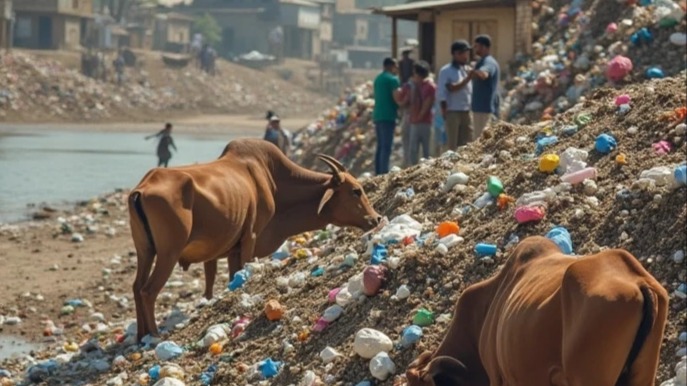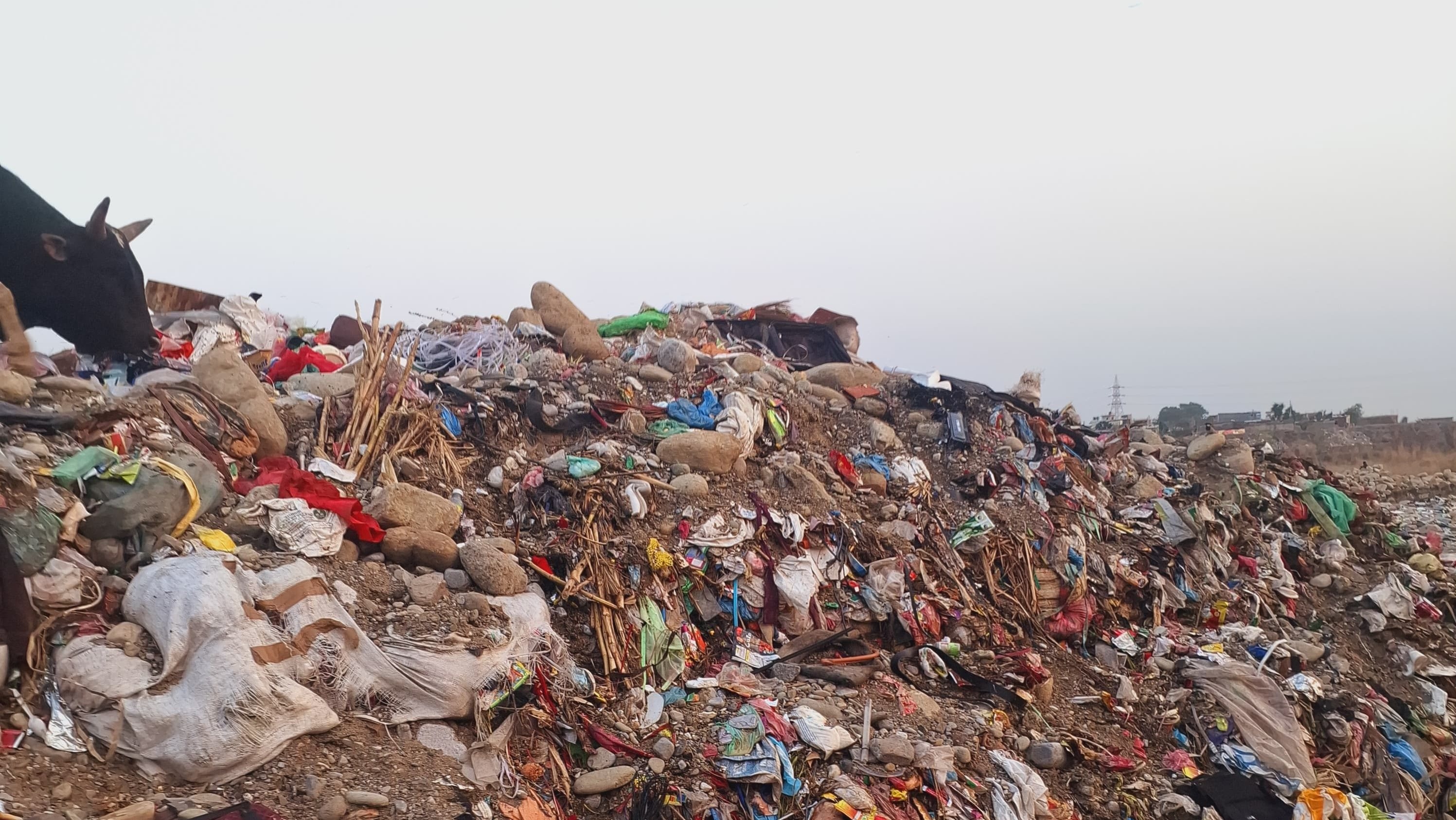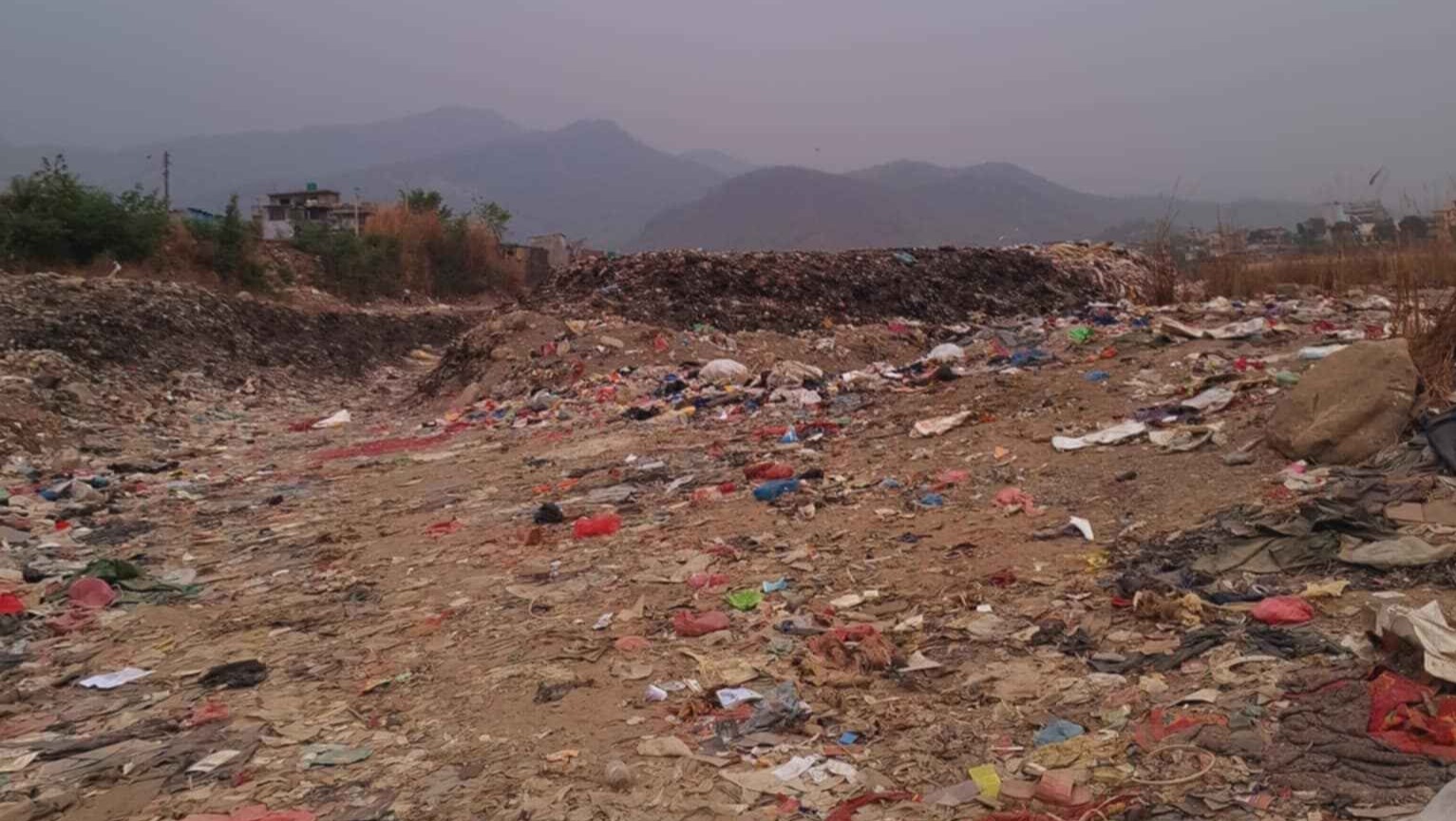The unmanaged waste disposal at the Majhuwa dumping site in Butwal has given rise to alarming environmental, health, and social crises. There is an urgent need for sustainable waste management practices and intergovernmental accountability.

June 06, 2025
Majhuwa, Butwal

Just two kilometers away from the Butwal city area lies a temporary dumping site in Butwal-11, Majhuwa, that has become a ticking time bomb for environmental degradation, public health risks, and community dissatisfaction. Established in 2021 by the local government, this site has been the central waste disposal area for Butwal Sub-Metropolitan City since then.
The Majhuwa dumping site is situated alarmingly close, at zero kilometers of the Tinahu River, on the riverbed itself. This has increasingly been posing a major threat of leachate contamination, especially during the monsoon season when rainwater can mix with decomposing waste and seep into the river.
Spanning across 10,000 square meters, it receives approximately 75 tons of waste daily from all 19 wards of the sub-metropolis, transported by about 40 tractors each day.
While the dumping site plays a crucial role in Butwal’s solid waste management, its placement and operation have triggered serious concerns. The facility is managed solely by the Butwal Sub-Metropolitan City with no budgetary support from the Lumbini provincial government, despite rising operational and environmental challenges.
|
[box-content-ad-1]
|
With no fencing, access control, or dedicated leachate management system, the Majhuwa dumping site lacks even the basic Environmental Health and Safety (EHS) infrastructure guidelines. The current practice at the dumping site involves dumping of mixed waste (organic, inorganic dry waste, and plastics) and covering it with soil and sand daily. Although drainage for perimeter water and erosion control on slopes are in place, these are insufficient safeguards, given the site’s vulnerability to environmental damage.

Representational AI-generated image of irregularly managed dumping site in Butwal
Photo: Seaart AI
Beyond the environmental implications, the health and dignity of residents have taken a heavy toll. A visit to the dumping site revealed this alarming reality. The situation was both disappointing and shocking. As one approaches the residential area, the foul smell burns the eyes and makes it difficult to breathe. The air is thick, heavy, and suffocating.
Not far from the heaps of garbage, we saw a 53-year-old woman, Devu Ghartimagar, a local resident near the dumping site, sitting outside her door watching her granddaughter play.
We approached and asked how they lived in the constant smell and waste around them. With a hint of grief in her eyes, she replied, “This is our fate. We have lived here for a long time before the establishment of this dumping site. First, the river water level rose so high that it became dangerous. We pleaded for help from the Sub-Metropolis, and they did come up with a solution. They decided to dig several meters below the river, but then this area turned into a dumping site.”
Local resident Ghartimagar took a pause before continuing with frustration in her voice, “Butwal Sub-Metropolis promised us health insurance, but we haven’t received it yet. The ward chairperson, the elites of our community, and the authorities—everyone has deceived us. And now, we’re left to suffer in silence.”
As we talked, other local residents from the neighborhood gathered around, curious. Another local resident named Laxmi Magar added , “The river isn’t threatening us anymore—the water level is low now. But every day, we have to live with this dumping site. We work hard doing physical labor all day. When we come home, all we want is to eat and rest. But the smell, the flies—it makes us feel sick. Sometimes we can’t even eat.”
The site’s proximity to residential areas has reportedly led to various health complications. The moisture from the waste, several feet below ground level, has reportedly started to contaminate the underground water sources, which the community depends on for drinking.
Women and children, in particular, are the most vulnerable to these impacts, suffering from skin conditions, headaches, and digestive issues. “The dumping site is so close that our children are getting ill too. They suffered from food poisoning for three days and we had skin allergies (luto) because the dumping site is open, without any cover, and exposed to the wind”, said local resident Magar.
As we made our way around the site, with every sight, the deep concern for the local people whose houses stand just meters away from the piles of waste only grew. Locals have been urging authorities to reconsider the location of the dumping site and implement immediate measures to protect the community’s well-being.
As the solutions begin with the acknowledgement, the environmental and public health sectors within the Butwal Sub-metropolis have been acknowledged, and they have expressed their worries.
"We do not want to comment in detail as it falls under the jurisdiction of the Department of Waste Management. However, as far as I am concerned, the presence of waste near residential areas definitely increases the risk of chronic diseases," said Yubaraj Pandey, Head of the Public Health Management and Disease Control Branch of Butwal Sub-metropolis.
Similarly, Yogesh Chapagain, Head of the Forest, Environment, and Disaster Management Department, added, "We don’t have much to say on this issue as it is primarily the responsibility of the sub-metropolis. However, the city’s water sources have become heavily polluted due to unmanaged garbage and potential leachate. Local aquatic plants are dying because of excessive chemical contamination in the river."
The main responsibility for solid waste management lies with the Sanitation and Waste Management Section of Butwal Sub-Metropolitan City. Thagishwor Pokhrel, the department head, underwent six months of training and has attended several waste management training programs through Urban Development Through Local Efforts (UDLE).
Pokhrel oversees the Majhuwa dumping site that operates under a 10-year contract. It functions with an annual budget of NRs. 30 million, funded entirely by the Butwal Sub-Metropolitan City. Initially, it had invested NRs. 20 million for constructing a side wall along one side of the dumping site. To date, approximately NRs. 100 million has been invested in the Majhuwa dumping site in Butwal.
So far, the site has not faced financial constraints. However, the lack of skilled manpower and modern waste management technologies is evident.
During the site visit, Dipak Khatri, an excavator operator, shared his concerns, “We need more professionally skilled people to do this work. The current manpower is insufficient and lacks technical training to manage this site effectively.”

Massive mixed waste pile at the Butwal dumping site.
Photo: DevPulse/ Prakriti Kafle
Despite the threat, long-term site planning and advanced technologies such as composting units, segregation machines, biogas plants, or waste compressors are still absent. The only infrastructure so far includes a partial safety side wall, tractors, and an excavator.
The main problem facing Butwal Sub-Metropolis is that it does not have a permanent and planned dumping site.
In 2010, the city signed an agreement with the Asian Development Bank (ADB) to construct a waste processing center with the capacity to process 83 metric tons of waste. However, the project, which was slated for completion by 2015, was scrapped in 2018 after local residents protested and refused to allow the city to bring its waste near their settlements. And then the Majhuwa dumping site was constructed in 2021.
“Before Majhuwa, the sub-metropolis had planned to set up a proposed landfill site at ward no 14, Tamnagar, 10 km away from the city, but that could not happen because of some issues”, says Sanitation and Waste Management Section head Pokhrel.
In the same year, Butwal Sub-Metropolis also signed a contract with the Butwal Sanitation and Environment Conservation Cooperative Organization to maintain and operate the Material Recovery Facility (MRF/ Compost plant) located in Ward No. 7, Shivanagar, Butwal.
In an MRF center, the recyclable portion of the inorganic waste is segregated and compacted for sale to recycling contractors, while the organic waste is converted into compost at the facility. However, the MRF currently can collect and process only 100 to 200 kilograms of waste per day, and it is located 1.5 kilometers from the city center.
Recognizing the growing risks and operational inefficiencies, the city is now preparing a proposal for NRs. 50 million to be submitted to the Lumbini Province Government. If approved, the funds would be used to build access roads and a full retaining wall around the dumping site. However, the proposal is still in the planning phase and has not yet been submitted.
Meanwhile, the problem in and around the Majhuwa dumping site is growing with the heaps of waste it keeps collecting.

Plastic waste scattered haphazardly around the dumping area of Butwal
Photo: DevPulse/ Prakriti Kafle
The crisis unfolding in Butwal is not an isolated incident. The Majhuwa dumping site symbolizes a larger crisis in urban waste management—one where short-term solutions come at the cost of long-term sustainability, health, and trust. Across Nepal, similar mismanagement stories are emerging, showing serious cracks marked by poor planning, outdated data, and environmental negligence.
In Bharatpur Metropolitan City, waste is being dumped in the Barandabhar corridor, a vital international wildlife passage that connects Chitwan National Park with forests to the north. This was also reported in a recent Mongabay investigation that revealed that the city’s landfill development was based on a falsified Initial Environmental Examination (IEE), which wrongly claimed the forest was barren.
Despite legal mandates for a full Environmental Impact Assessment (EIA) before constructing landfills in forest areas, Bharatpur officials proceeded using outdated and misleading documents. The Department of Forests has not approved tree felling, yet local authorities continue dumping, citing the lack of alternatives, jeopardizing not just forest biodiversity but also undermining federal investments like elevated roads for safe wildlife movement.
|
[banner-content-ad-1]
|
Similarly, in the Mayadevi Rural Municipality of Kapilvastu, waste disposal is equally chaotic. Although two dumping sites exist in Abirawo and Chakalchaudaha Partiya, locals frequently dispose of waste haphazardly—on roadsides, near homes, and in open spaces—posing major health and sanitation risks.
And more infamously, the Bancharedanda and Sisdol waste management crisis of the Kathmandu valley as well as the discussion around them hog the front-page headlines, with no avail or solutions to date.
All these examples show that there is a need for urgent nationwide attention from the government. Without urgent intergovernmental collaboration, strict environmental regulation, and a shift towards science-based waste processing solutions, the consequences will be dire, not just for ecosystems but for the people who live in their shadow every day.
The environment cannot wait—and neither can the people.

By sharing valuable information and sparking inspiration, we aim to foster growth, innovation and brighter opportunities for future generations.
Contact us